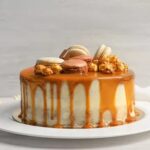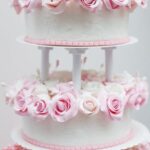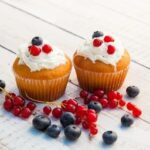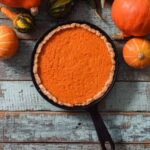Are you ready to take your cake decorating skills to the next level? In this article, we will explore the art of creating delicious and versatile cream for decorating cakes. Whether you’re a baking enthusiast looking to enhance your sweet creations or a professional pastry chef wanting to perfect your craft, mastering the art of cake decorating with cream is a must.
If you’ve ever wondered how to make cream for decorating cake, you’ve come to the right place. We’ll delve into different types of cream suitable for cake decoration such as buttercream, whipped cream, and cream cheese frosting. By understanding the various options available, you’ll be able to choose the best type of cream for your specific cake decorating needs.
Now let’s dive deeper into making cream for decorating cakes by examining the essential ingredients needed in creating these luscious toppings. From there, we’ll provide you with a step-by-step guide on how to make buttercream – a classic and versatile option that is perfect for piping and creating stunning designs on cakes. So get ready to unleash your creativity and impress everyone with your beautiful and delectable cake decorations.
Types of Cream for Cake Decorating (Buttercream, Whipped Cream, Cream Cheese Frosting)
Buttercream
Buttercream is one of the most popular types of cream used for decorating cakes. It is made with butter or shortening, powdered sugar, and flavorings such as vanilla or chocolate. Buttercream can be easily colored and flavored to suit any cake design or theme. There are different variations of buttercream, including American buttercream, Swiss meringue buttercream, and Italian meringue buttercream, each with its own unique characteristics and uses in cake decorating.
Whipped Cream
Whipped cream is light and airy, making it a great option for those who prefer a less sweet frosting on their cakes. It is made by whipping heavy cream with sugar and vanilla until stiff peaks form. Whipped cream is best used as a filling between cake layers or as a topping for fruit-topped cakes due to its light texture.
Cream Cheese Frosting
Cream cheese frosting has a tangy flavor that pairs well with carrot cake, red velvet cake, and other rich-flavored cakes. It is made by blending cream cheese with powdered sugar, butter, and vanilla until smooth. Cream cheese frosting is known for its creamy texture and ability to hold up well in warmer temperatures compared to other frostings.
These three types of cream offer different flavors and textures that cater to various tastes and preferences when it comes to decorating cakes. Each type presents its own advantages when it comes to working with them in creating beautiful cake designs.
Essential Ingredients for Making Cream for Cake Decorating
When it comes to making cream for cake decorating, the right ingredients can make all the difference in achieving that perfect texture and flavor. Whether you’re using buttercream, whipped cream, or cream cheese frosting, there are essential ingredients that are common across all these types of cream. Here are some of the key ingredients you’ll need to have on hand:
- Butter: For buttercream and cream cheese frosting, unsalted butter is typically used as the base ingredient. It’s important to allow the butter to reach room temperature before using it in your recipe to ensure a smooth and creamy consistency.
- Sugar: Granulated sugar or confectioners’ sugar (also known as powdered sugar) is used to sweeten and stabilize the cream. The type of sugar you use will depend on the specific recipe you’re following.
- Heavy Cream: This is a key ingredient for making whipped cream. It needs to be very cold when whipped in order to achieve stiff peaks.
These are just a few examples of essential ingredients for making cream for cake decorating. Different recipes may call for additional flavorings such as vanilla extract or almond extract, but these core ingredients form the foundation for creating delicious and beautifully decorated cakes.
Understanding the role that each ingredient plays in your chosen cream recipe can help you achieve the best results. The right combination of ingredients will result in a smooth, creamy texture that holds its shape when piped onto a cake or used for other decorative purposes. So make sure you have these essential ingredients on hand when preparing to decorate your next cake.
Step-by-Step Guide on How to Make Buttercream
Gathering Ingredients
Before you start making buttercream, make sure you have all the necessary ingredients on hand. This includes unsalted butter, powdered sugar, vanilla extract, and heavy cream. Make sure the butter is at room temperature before you begin.
Mixing the Ingredients
To make buttercream, start by creaming the butter in a mixing bowl until it is smooth and creamy. Gradually add the powdered sugar, mixing well after each addition. Add the vanilla extract and heavy cream, then continue to mix until the buttercream is light and fluffy. If you want to add color to your buttercream, now is the time to mix in a few drops of food coloring.
Adjusting Consistency
If your buttercream is too thick, add more cream a little bit at a time until you reach your desired consistency. If it’s too thin, gradually mix in more powdered sugar until it becomes thicker. Remember that room temperature will also affect its consistency so be observant of environmental conditions.
By following these steps, you can easily make delicious and creamy buttercream for decorating cakes. Whether you’re piping flowers or spreading icing on a cake, this versatile frosting is perfect for adding flavor and beauty to any dessert.
Tips for Making and Using Whipped Cream for Cake Decorating
Whipped cream is a light and fluffy option for decorating cakes, providing a delicious and airy texture to your creations. When making and using whipped cream for cake decorating, there are a few tips that can help ensure success.
First, it’s important to start with heavy whipping cream that is very cold. This will help the cream whip up faster and hold its shape better once it’s whipped. Additionally, chilling your mixing bowl and beaters in the refrigerator beforehand can also aid in achieving the desired consistency.
When making whipped cream, it’s essential to avoid over-whipping, as this can result in a grainy texture and even butter forming. The key is to stop whipping as soon as stiff peaks form, meaning the cream holds its shape when the beaters are lifted. It’s also recommended to add sugar and vanilla extract towards the end of whipping to ensure the incorporation of flavor without risking over-whipping.
Once the whipped cream is ready, it should be used immediately for decorating cakes or desserts. If you need to make it ahead of time, stabilizing it with gelatin or cornstarch can help maintain its structure. Whipped cream decorations should be kept refrigerated until serving time to prevent melting or deflating. With these tips in mind, you can create beautifully adorned cakes using whipped cream as a versatile and delectable topping.
Techniques for Decorating Cakes With Cream (Piping, Swirls, Rosettes)
Decorating cakes with cream can be a fun and creative way to add a personal touch to any dessert. There are various techniques for using cream to decorate cakes, including piping, swirls, and rosettes. These techniques can take your cake decorating skills to the next level and make your creations stand out. Here are some popular techniques for decorating cakes with cream:
1. Piping: Piping is a versatile technique that involves using a piping bag to create intricate designs on the surface of the cake. Whether you want to write a message, create borders, or make detailed patterns, piping allows for precision and artistic freedom.
2. Swirls: Swirling cream onto a cake can create a beautiful and elegant effect. Using a round piping tip, start from the center of the cake and work your way outward in a circular motion. This technique works well for creating borders or covering the entire surface of the cake with swirls.
3. Rosettes: Creating rosettes with cream is a popular technique that adds an elegant and decorative touch to cakes. Using a star-shaped piping tip, start in the center of the cake and pipe in a circular motion while applying even pressure to create beautiful flower-like designs.
Using these techniques for decorating cakes with cream can elevate your baking game and impress your friends and family with stunning desserts. Practice makes perfect, so don’t be afraid to experiment and try new designs.
Alternative Options for Cream Decoration (Fondant, Gum Paste, Royal Icing)
While cream is a popular choice for decorating cakes, especially for its delicious taste and smooth texture, there are alternative options that can be used to achieve beautiful and unique cake decorations. Fondant, gum paste, and royal icing are all viable options for creating stunning cake designs.
Fondant is a pliable sugar dough that can be rolled out and draped over cakes to create a smooth finish. It can also be molded into intricate shapes and figures to adorn cake tops. Gum paste is similar to fondant but dries hard, making it ideal for crafting delicate flowers and other decorative elements that need to hold their shape.
Royal icing, on the other hand, is a hard white icing made from egg whites and powdered sugar. It can be used to create intricate lace-like designs or piped details on cakes.
Each of these alternatives offers different advantages depending on the desired design and effect. Fondant provides a clean canvas for elaborate decorations while gum paste allows for more detailed and delicate work. Royal icing is perfect for intricate patterns and details that require precision.
Incorporating these alternative options into cake decorating opens up endless possibilities for creativity and personalization. Whether it’s a wedding cake with elegant fondant draping or a birthday cake adorned with whimsical gum paste figures, these alternatives are valuable tools in creating stunning cake designs that cater to various themes and preferences.
| Decorating Option | Advantages |
|---|---|
| Fondant | Provides a smooth finish & ideal for intricate shapes |
| Gum Paste | Dries hard & perfect for delicate flowers & decorative elements |
| Royal Icing | Ideal for intricate patterns & details that require precision |
Troubleshooting Common Issues When Making Cream for Cake Decorating
When it comes to making cream for cake decorating, there are a few common issues that may arise, but with the right knowledge and techniques, these problems can easily be resolved. One of the most common issues is the cream being too runny or too stiff.
If your cream is too runny, try adding more powdered sugar if you’re using buttercream, or more stabilizers such as gelatin if you’re using whipped cream. On the other hand, if your cream is too stiff, try adding a small amount of milk or heavy cream to loosen it up.
Another issue that may occur is air bubbles in the cream. This can be a problem when working with whipped cream, as overmixing can cause an excess of air to be incorporated into the mixture. To avoid this issue, make sure to whip the cream just until it reaches stiff peaks and then stop immediately. If air bubbles do form, gently tap the bowl on the counter a few times to release them.
Additionally, another common problem is curdled or separated cream. This often happens when working with buttercream frosting due to temperature fluctuations or overmixing. To fix this issue, try placing the bowl of frosting in hot water and stirring gently until it comes back together. If working with whipped cream or cream cheese frosting, make sure all ingredients are at room temperature before mixing.
It’s important to keep in mind that troubleshooting these issues may take some practice and experimentation, but by following these tips and understanding how different creams behave, you’ll be able to create beautifully decorated cakes without any problems.
| Common Issues | Troubleshooting Tips |
|---|---|
| Cream too runny or too stiff | Add more powdered sugar/stabilizers if runny; Add small amount of milk/heavy cream if stiff |
| Air bubbles in the cream | Whip just until stiff peaks are formed; Gently tap bowl on counter to release air bubbles |
| Curdled/separated cream | Place in hot water and stir gently; Ensure all ingredients are at room temperature |
Conclusion and Final Tips for Beautiful Cake Decoration Using Cream
In conclusion, mastering the art of making cream for decorating cakes opens up endless possibilities for creating stunning and delicious confections. Whether you prefer the richness of buttercream, the lightness of whipped cream, or the tanginess of cream cheese frosting, there is a cream type to suit every preference and occasion. By understanding the essential ingredients and following a step-by-step guide, anyone can learn to make their own decadent cream for cake decoration.
When it comes to using cream for cake decorating, it’s important to pay attention to techniques such as piping, swirls, and rosettes. These skills will elevate your cakes from simply tasty to visually stunning works of art. Additionally, while cream is a popular choice for cake decoration, it’s also worth exploring alternative options such as fondant, gum paste, and royal icing for more intricate designs.
Finally, when encountering common issues in cream making such as curdling or consistency problems, don’t be discouraged. With patience and practice, these challenges can be overcome. Ultimately, experimenting with different types of cream and decoration methods will lead to finding your own unique style and achieving beautifully decorated cakes that are sure to impress any audience. So go ahead and let your creativity flow as you explore the world of cake decoration using various types of creamy delights.
Frequently Asked Questions
How to Make Fresh Cream to Decorate Cake?
To make fresh cream for decorating cakes, start by chilling a metal bowl and beaters in the freezer for about 15 minutes. Once chilled, pour cold heavy cream into the bowl and beat it on high speed until soft peaks form.
Add powdered sugar and vanilla extract to sweeten the cream, being careful not to overmix it. The fresh cream is now ready to use for decorating your cake.
What Cream to Use for Decorating Cakes?
When it comes to decorating cakes, it’s best to use heavy whipping cream or double cream with a high fat content. These types of creams hold their shape well when whipped, making them ideal for creating decorative swirls and designs on top of cakes.
Avoid using light whipping cream or half-and-half, as they may not hold their shape as effectively.
What Are the Ingredients for Making Cream for Cakes?
The main ingredients for making cream for cakes include heavy cream with a high fat content, powdered sugar (or granulated sugar if preferred), and vanilla extract for flavoring. These simple ingredients come together to create a rich and creamy topping that is perfect for decorating cakes and adding a touch of sweetness.
It’s important to chill the equipment and use cold ingredients to ensure the cream whips up properly and holds its shape when decorating the cake.

Welcome to my blog about home and family. This blog is a place where I will share my thoughts, ideas, and experiences related to these important topics. I am a stay-at-home mom with two young children. I hope you enjoy reading it! and may find some helpful tips and ideas that will make your home and family life even better!





